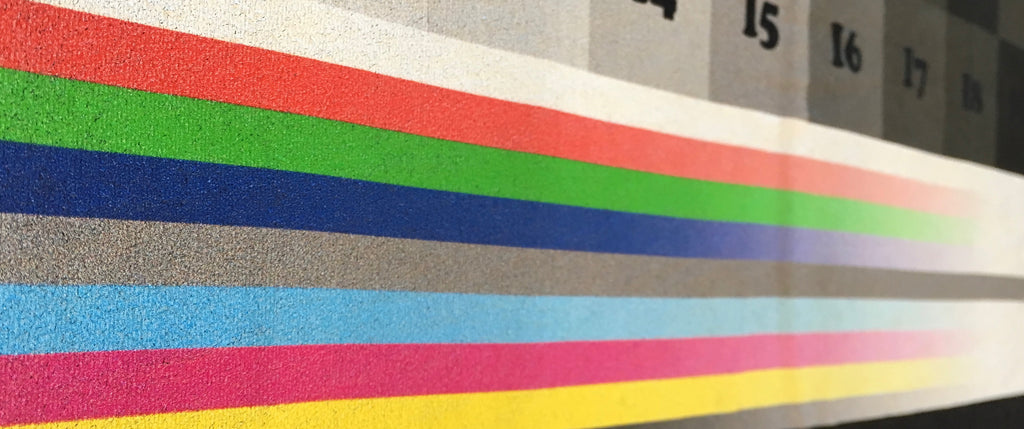Direct To Garment - DTG

Summary
Direct To Garment, also known as DTG is the process of printing liquid garment ink directly onto the fabric or garment. These inks are typically designed for printing onto cotton and some machines don’t have white ink so are only suitable for printing directly onto white/light garments with a high cotton content. Once the ink is printed, it is cured using heat either directly applied using a heat press or the printed garment is placed in a drying unit.
For darker garments, a pretreatment solution needs to be applied/sprayed onto the area to be printed which is a water based salty glue mix. This helps the white underbase ink adhere to the garment for great durability. Larger more expensive DTG machines are loaded with a thick, gloopy white ink made from titanium dioxide which is laid down first as a white underbase on dark garments so when the colour inks are printed on top they appear bright and vibrant. Without a white underbase, DTG garment inks printed onto dark substrates simply wouldn’t be visible.
This is a great method for decorating garments and the printed graphic has a durable stretchy rubbery feel which lasts as long as the garment, typically one to two years. While good t-shirt design ought to have negative space (areas which aren’t printed and the garment colour shows through to form part of the design) it is possible to print larger areas using DTG without any major deterioration of the print over time.
Get in touch with us if you need some DTG printing done.
Issues
Most of the issues with DTG printing fall to the printer owner/operator rather than the end user. The white ink machines are notorious for clogging and needing very regular agitation to stop them settling and blocking the ink lines. Maintenance cycles are required regularly and rigorously and due to the amount of maintenance required, these machines need to be printing shirts all day long to justify the time required for maintenance and ink wasted from maintenance cycles.
If a pretreat solution hasn’t been applied properly, meaning the correct amount in a consistent coverage for the area to be printed, then there could be some issues with the print flaking/cracking after some washing. Always ensure you are ordering from a reputable provider.
DTG Requirements
- Machine - Specially designed DTG printer
- Transfer Media - None required as printed straight onto the garment
- Print Size - Machine specific, some can print A5/A$ size and other upto 400x600mm or more Process (for dark garments) - Pretreat applied, cured, white underbase printed, colour ink on top then cured
- Process (for light garments) - Sometimes pretreat is used but other times the colour ink is printed straight onto the garment and cured afterwards - No white ink is used.
- Substrate Type - Fabric with high cotton count, 100% is best for the waterbed inks but cotton/poly blends down to60/40 split can also be DTG printed
- Equipment - Pretreat sprayer/machine, DTG printer, Heat press to suit the size & shape of the design on the substrate and optional dryer unit.
- Substrate Colours - White/light garments for machine with no white ink, any colour for machines with white ink capability.
- Ink Colours - Full-Colour CMYK (Cyan, Magenta, Yellow & Key/Black) plus White ink for machines that have it.
- Cost of Media - Medium. Ink can be expensive depending on the machine and how much the machine is used.
- Suitable Artwork - Perfect for full colour, blacks & whites for machines that have it. Reasonable detail levels are possible and this process is suitable for large print areas too.
Get in touch with us if you need some DTG printing done.

Let customers speak for us
from 785 reviewsGreat colour, lovely packaging. Thank you

Quick shipping, great product and style

Great design, great quality & prompt delivery.

High quality transfer received quickly!

Very good quality t shirt

Very responsive to dms. Arrived quickly despite Christmas and looked good. Was kind of hard to apply but I don't think that's a product issue. Would happily purchase again!

Looking forward to seeing him wearing this. Thank you

Great t-shirts
Good quality

This color chart is very useful for anyone working with CMYK printing.

Phil is so flexible and friendly.
This is the second time I've ordered from him, and won't hesitate to use PhoxyPrinting in future.
Outstanding.

Seems really good

As always, fantastic service and product.

Awesome tshirt. Was very well received. Great communication with seller.

I ordered custom waterslide transfers for a short run of product prototypes. They were very small and detailed.
I was extremely happy with the company communication, the quality of the transfers and the fast turnaround time, which allowed me to hit my tight deadline.
Thank you.
